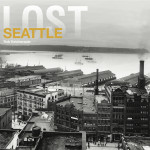Soundwalls and screens will take away the precious views from freeways, likely resulting in outrage and political backlash from selfish, pampered drivers. Here's an email exchange about screens for the I-90 bike path after shoulders are removed:
This is part of the special feature Freeway Box, showcasing my old life next to freeway viaducts.
--------------------------------------------------------------------------------
From: Robert Ketcherside
Sent: Wednesday, June 16, 2004
Subject: I-90 Screens
Hello,
I was reviewing the images of screening material that are included in 4.3.4 of the Final EIS for I-90 HOV lanes.
I'm curious about what the railing is supposed to solve. It doesn't seem to be explicitely mentioned in the EIS. The goal of the facility may dictate the best solution.
Is this only supposed to stop life-threatening projectiles from leaving the roadway? In my experience walking across I-90 during the morning rush hour, there is an existing problem with sand leaving the roadway, which enters eyes and mouth of non-motorized commuters. This problem is especially bad on the east bridge, where the shoulder is narrower. Most or all of the railings and meshes depicted wouldn't have an impact at all on sand, though all but the lowest would stop a chunk of tire, tail pipe or hub cap.
In the written description of mitigation, plexiglass is listed as an alternative. Did you create any simulations of alternatives with weathered plexiglass? I suspect that plexiglass is my preferred mitigation because it will entirely stop sand, but I also know that plexiglass does not stay clear, based on those I've seen on freeways in Japan.
-------------------------------------------------------------------------------
[From Sound Transit I-90 Project Manager]
Sent: Tuesday, June 22, 2004 4:17 PM
Subject: I-90 Screens
Dear Mr. Ketcherside,
I am the project manager for the I-90 Two-Way Transit and HOV Operations project. I am responding to your recent email about the I-90 project.
With the Preferred Alternative R-8A, the traffic lanes would be moved closer to the shared-use pathway on the Homer Hadley floating bridge. Currently the shared-use pathway is separated from traffic by a 32-inch high traffic barrier and a 10 foot shoulder. The shoulder would be reduced to 2 feet in width. The screening options depicted in the figures in Section 4.3 are described in Section 3.4 Pedestrian/Bicycle Access as mitigation measure TRAN-30 (page 3.4-10 of the Final EIS). They are intended to reduce the proximity impact of the westbound traffic, specifically wind from passing vehicle, roadway debris, and glare from on-coming traffic. Additional screening will be added on the floating bridge, but the decision has not been made as to what type of screening will be installed.
The standard railing is a type ?BP? railing, simulated as ?Railing Option A?. Other design options include chain-link fencing, wire mesh panels, lightweight concrete panels, or PlexiglasTM panels mounted on top of the concrete barrier for a total height of 6 to 8 feet. The simulation of ?Railing Option B? shows wire mesh panels. ?Railing Option C? depicts PlexiglasTM panel screening.
As part of final roadway design, a decision will be made by WSDOT on the type of screening to be used. Design issues that would be considered include wind loads on the bridge, maintenance issues, safety and security issues, reductions in access to the shared-use path as a refuge for motorists with disabled vehicles, and aesthetic concerns including views to the south from the pathway and views to the north from the roadway.
The travel lane proximity to the shared-use path on the East Channel Bridge would not be changed by the implementation of Alternative R-8A. It is recognized that similar issues of wind, debris and headlight glare exist for pathway users today crossing the East Channel Bridge. Sound Transit has committed to evaluate the addition of screening on the barrier separation on the East Channel Bridge as part of final design work. We will work with WSDOT to evaluate the effectiveness of the screening options, maintenance issues and the design issues before a decision is made on whether additional screening can be added in this location.
Work on the final design is expected to begin later this year. It will likely be sometime in mid-2005 before screening is selected for the Homer Hadley floating bridge, and before we have the results of the evaluation for additional screening for the East Channel Bridge.
--------------------------------------------------------------------------------
From: Rob Ketcherside
Sent: Tuesday, June 22, 2004
Subject: RE: I-90 Screens
Thank you for your prompt reply. I'm sorry for not noticing that Railing Option C is plexiglass - I didn't catch the connection in the text, and it didn't look like my expectation of plexiglass. Personally this is my preference.
Do you know what the outreach plan will be during the decision phase for materials? I'd like to know if I should just watch for a press release, or if timing has already been decided.
--------------------------------------------------------------------------------
[From Sound Transit I-90 Project Manager]
Dear Mr. Ketcherside,
We are developing our scope of work for final design now, so the exact schedule for work on the screening is not confirmed.
You can monitor the Sound Transit website, www.soundtransit.org, then go to projects, then I-90, for project information. We will put information up there.
We will also be working with the Sound Transit Bicycle Leaders Team which includes representatives from the Cascade Bicycle Club, the Bicycle Alliance of Washington, the Seattle Bike Club and others to get their input.
